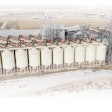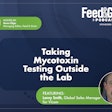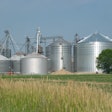Grain bins are no place for humans. Extreme temperatures, dust, mold and the risk of engulfment are ever-present dangers that injure and kill people every year.
Steven Kilger, the host of theFeed & Grain Podcast, talks with Chad Johnson, CEO atGrain Weevil Corp., about theGrain Weevil, a robot designed to level grain and break up damaged grain in grain bins. The robot is propelled by two augers and uses gravity to do what used to be a very dangerous and time-consuming job.
Transcript
Steven Kilger (00:00):Hello everyone. My name is Steven Kilger, managing editor ofFeed & Grain, and host of theFeed & GrainPodcast.
Kilger (00:06):Today, my guest is Chad Johnson, CEO at Grain Weevil Corp. Chad is here to talk about a grain bin robot being developed by his company that will hopefully someday soon eliminate the need for producers and green professionals to enter filled grain bins. It's a really interesting technology that, hopefully soon, could change the industry for the better.
Kilger (00:28):Before we get to that conversation, some housekeeping notes. If you're listening to this podcast within a podcast app, please consider subscribing and or leaving a review. If you have an idea for a topic you would like me to cover or someone in the animal feed, grain handling, or related industries you'd like me to talk to, reach out and let me know. This podcast’s page onfeedandgrain.comhas a button right under the title that will let you send an email directly to me where you can give me all your suggestions. I'd love to hear from you anytime.
Kilger (00:58):With that other way, Chad, thank you again for talking to me today. Can you just tell me a little bit about yourself, who you are and how you got into the industry.?
Chad Johnson (01:05):My name is Chad Johnson, and I'm the CEO of the Grain Weevil Corporation. And we're actually a father-son robotics company that builds a grain bin safety and management robot.
Kilger (01:18):It's a very cool robot, and we'll talk a lot about it. But your father-son company, How did you kind of first get this idea to make a grain bin robot?
Johnson (01:27):We were actually giving students all across the state of Nebraska opportunities to learn workforce skills through innovation in my previous job. It just so happened that my son Ben was our guinea pig. So, he got to do a lot of activities and challenges around that thought process. He was getting ready to go into electrical engineering at the University of Nebraska in Omaha.
We were just trying to give him opportunities to learn workforce skills. He started building a robot platform for a completely random purpose for a startup in Chicago. And he built this really cool robot that could follow any colored shirt, like through a factory, as they were capturing video about workflow efficiencies and those kinds of things.
That was built was freshman year in college, and the local farmers saw it, and one of our family friends and he saw that robot. He said, “Man, if you can build that thing, build me one to keep me and my kids out of a grain bin.” So, it started it was a challenge from a local farmer.
我和我的儿子从来没有粮仓内性能试验ore we started, which has been actually a tremendous help for us. Because we've made absolutely no assumptions, we don't know enough about grain to make assumptions. So, it's hundreds upon hundreds of interviews and talking to farmers to get feedback about how to build this machine. So, it's something that our mission has become, “no boots in the grain.” That is our goal is that no one ever has to stick their boots in the grain to solve a problem or to maintain best practices of grain storage. And so that's what the challenge has been to build that machine, so people stay safe.
Kilger (03:29):Yeah, that's insane that you kind of came at it from this outsider's perspective. Which is always nice, especially since you have your own expertise to bring in, but you said you interviewed a bunch of people to kind of figure out what the conditions were like and what the industry needed. Then, how did you go about that? Did you just go up to your local farmers and kind of be like, “Hey, what's going on? Can I talk to you about bin safety? How did that work?”
Johnson (03:52):First of all, the farmer in the families that challenged us is probably the best resource that any ag tech company could ever have. They are early adopters; they challenge you, they try new things, and they're willing to let us tell us that it's been great. They were really that first initial push for us, probably the coolest piece of our customer discovery.
机器人的周六开了冷杉st time in March of 2020. We have a neighbor who’s a patent lawyer. So, we ran home from the grain bins and got our neighbor to help us write our provisional patent submitted on Monday. On Tuesday, there was a showing at the local movie theater of the movie Silo. And that's that film about someone dying in a grain bin, the rescue of the young man that tried to save the older gentleman, it is just really, really powerful. And our corn association was hosting that movie, so there were hundreds of people and their farm families.
We had a table up front with this really ugly 3d printed duct-taped together robot and a little video of it working for the first time. And that's all it was, like 15 seconds of this thing going up and coming back, had a whiteboard with sticky notes. And we just sat out there in the lobby, a very emotional movie, people coming out and saying, “Man can it do this, can it do more, can you make it do this? And we have hundreds of little sticky notes and questions. But someone actually took a little video with their phone of our video, put it on Twitter, got 80,000 views in about two weeks and a couple of 100 direct messages saying, “hey, what can this thing do? We're interested.” That's when we knew it was a hit.
So that's how that really started was just throwing it out there and saying, what can this do for you? That was how it started. And we've just continued to have tests and trials, and we do something, we throw it out, say, hey, we just did this. So what? How can it help? And like I said, hundreds of farmers are more than willing to tell us the way to do it. Listen, the way I do it, that thing's not going to work because it can't do this. It's just been wonderful to have the support and feedback from the local farmers from the grain industry all the way through the whole chain, has been interested in helping us.
Kilger (06:33):Great. Yeah, I heard of you last year at theGEAP's Exchange, where you guys presented the video. It's very exciting because you're so futuristic. Well, number one, a lot of people are still using a long pole to go in there jab at grain or lowering something into the grain that whips it around. That I actually have something in there that you can be in control of. And it just feels a little bit like, finally, we're going into the future of grain conditioning technology. So that's really awesome. Can you tell me a little bit just about how it works? What does it do once it's in the bin?
Johnson (07:11):Sure. So, starting out lately trying to solve a problem to take care of anomalies. Crusts, bridges and pillars are stuck. So, to do that, we went through, as I said, we’d never worked in the grain industry. So made a lot of my original thoughts and processes. Hey, let's build a little remote-control snowmobile-type thing with paddle wheels. It's like now that you look at it and say, oh, yeah, augers! The most likely reason that you use an auger is to move grain. So, if you want to build a robot that moves, great, I'll use augers.
It took us a little while to get there. But once we kind of made that discovery, so we have two augers, so you think of it like a tank. But there are augers instead of treads. And those augers both propelled the robot on the surface of the grain and manipulates the grain at the same time. So instead of building a great big giant machine that can do a lot of work, build a small, compact, powerful machine that actually tries to take advantage of gravity. So, we run on that surface; really, if we're going to level a grain bin, we're trying to get gravity to do most of the work.
That's where the intelligence of this machine comes into play, is we're running the right patterns on the surface so that the grain settles into a state of being level. The power comes in when you run into too, you know, wet grain or crusted grain, and we can break that up and get it to flow again. So, that was the initial process, and then we realized they could do a lot more than that. It can run on flow.
As you're filling the green bins up, it can act as a spreader, and it prepares layer by layer, so you have the best airflow to help maintain grain quality. We can run on your pulling it up so that you can push those big sidewalls down, so you don't have the risk of avalanches makes the extraction process a lot more efficient and a lot safer.
Kilger (09:18):I imagine it also helps keep your grain bin a lot cleaner because that's the stuff that's hard to get to once you have a completely empty bin and you're up there trying to get the things off the wall and all that. If you can, eliminate that as it's going down. That's just the benefit. And also, don't discount yourself. Who would have thought that augers would make good propellers?
Johnson (09:36):When we started looking, there's actually a bunch of like big military tanks with these great big screw drive systems that float across the in swamps and all these things back from the 50s. And there's, you know, we didn't invent the screwdriver propulsion. We just got lucky enough to put two and two together. And build a machine that can maneuver on the grain, which is very unique. So, yeah, it's been out there before, but you’d think that that would be the first thing people would think of is, yeah, let's use augers.
Kilger (10:14):I can tell you right now, you could have put me in that design booth for 50 years. I would have never thought of that. So, then someone is truly remotely controlling it from the outside, correct? And then it has patterns that you can kind of be like, “Oh, I want to do this, this zig-zag pattern.” And it goes in, and we'll start kind of moving that as you're operating it.
Johnson (10:32):Yes. So today, we have what we call human-controlled automation. So, we go put in the robot, and we have a camera system. We're outside, we're controlling the robot, but then we can activate a pattern. And that's the way that operates.
Now, very soon, it will be supervised autonomy, which means it's mostly autonomous, but we still need humans to kind of make sure it's not getting somewhere that it shouldn't. It just takes such a long time to overcome the fluid dynamics of grain and the hazards and dust. And so, we still have to kind of ensure that the robot is doing what it's supposed to do. And then, eventually, it'll be 100% autonomous. You throw it in that task that you want it to do on your phone, and then go watch football.
A couple of little phases in there. But right now, human controlled with autonomous capabilities very soon. It's mostly autonomous with human oversight, and then it'll be fully autonomous. And that's when it's going to make a big difference in workflows. I don't have to allocate time to do these tasks. Just let it happen.
Kilger (11:54):Yeah, that's exciting. Well, I mean, you guys have already come so far because what did you say it was in 2020 that you had your first successful test? And when did you start working on the project in general?
Johnson (12:04):So, it's really the summer of 2019. But Benjamin was still in college and not home. So, it would just be on a weekend, or I go to Omaha, and we worked in his little apartment kitchen, or he'd come home, and we worked at our workshop here at the house. And so, we just tinkered on it for a while. Like I said, we tried a couple of not-so-successful tests. December was the first time we tried to do an auger-based robot; we made three auger-based robots that did not work.
Actually, if you come to our facility in Omaha, all of them are up on the wall. And there are three of them that didn't work. And then the one in March of 2020 was the first one that actually could function, drive, turn and move grain. That was very exciting.
Kilger (12:58):Well, people don't realize how different grain is and the environment of a grain bin is. Because, as you said, there's dust you have to worry about, and there's the potential for, I imagine, the robot to get buried in grain. Does it just dig itself out at that point, does it? How does that work?
Johnson (13:12):It does dig itself out up to a certain point. Yeah, obviously, if you're 40 feet under grain, the pressures are tremendous. But it's interesting because we'd like to joke around a little bit about it; grain bis are no place for humans or robots. I mean, it is a hostile environment. We’ve measured temperatures at ambient air temperatures of 120 degrees; grain temperatures vary so much. We have got to operate, like now, when it's cold outside. So, you have the depth. Then think of the grain as a fluid. It kind of sticks where it's here, but then once we start moving on, it starts flowing like a fluid.
That makes it extremely challenging to do autonomous code and make sure we know where we're at inside of the grain bin. It's not like a Roomba, which has a reference point, and they know how far they traveled forward, and then they can check the Wi-Fi.
我们的位置在绿色本是一个完全custom-designed technology. No GPS signals like those outdoor tractors get to use this. This environment is tough to design machines around. So, it's fun. It's exciting. But it's a difficult challenge.
Kilger (14:36):If you're going to produce a farmer clientele to, you know, there's a lot of variation in the bins that are out there. It's not like a grain elevator where their entire job is basically keeping that grain in good condition. And that's what they do. So I imagine it's a huge challenge. And it's silly. It's almost like you're designing a robot for another planet. But how is production going? What phase of testing are you guys at?
Johnson (15:01):Now, we have some active on-farm trials. And were able to do on-the-farm trials. Because grain bins are classified as hazardous locations at commercial facilities. It is safer for us to test and operate on the farm because of the ventilation and all the things that we can do there. So, we have some on-the-farm trials, and we are working on to commercial facility trials, where we can go in and do some testing on a commercial scale. But very limited on that front. Because of the hazardous certification process.
We are at the last of our prototyping machines. In January, we will have our first we're calling them our pre-production machine. And those are going to be the machines that we start the certification process with to make sure that we can operate in a class two Division One, dust explosion environment, or robotics safe design with Spark-free motors and our batteries are super safe, and all of them are safe. It's just a matter of now putting the final package together and getting those listings from the testing labs that say that we are dustproof and ignition-proof.
Then we can go all into the commercial facilities and start doing our real testing. Our biggest challenge is not can we level grain or can we break up crust. It's can our machines operate within the workflows of the commercial facilities, the processing plants and the farms and building it out so that it does that.
Kilger (16:30):Oh, as an industry, we're pretty aware of the regulatory hurdles everything has to go through. But yeah, that's it's amazing. We're, I'm looking forward to going to grain facility one day and seeing it over there in the corner and be like, hey, the Green Weevil know about. I'm sure it will take off. Because, as I said, it's just so much more advanced than anything I've seen in the industry that I've been covering. So really cool, really cool project; make sure you keep us informed on its progresses. Is there anything else you'd like to tell our visitors? Is there any way they can help? Should they just kind of sit there and wait? Is there a newsletter they can sign up for? What's going on?
Johnson (17:09):You can follow us on social media. Just a fair note all of the TikTok accounts where there are like some 60 million views, and things are not ours. We got a super fan page that is one of the teenage boys at the farm. We test that and post videos and stuff every once in a while on that. But Twitter, we do have an official Twitter account; it’sgrain_weevil, and you can follow us there.
We do have surveys and newsletters that you can sign up for on our website. We do try to post a lot of videos of what we're working on. For example, it's, “Hey, we just did a video of us leveling a grain bin that's 22% Moisture corn,” and then get feedback on how does that impact your operation. What are the challenges? What do you guys know about this? So that we can help see how to fine-tune our machine to make the best return on investment for everyone that might be able to use it.
Kilger (18:08):Yeah, that's awesome. And I will make sure all that gets linked in the show notes below. So, you can click over and follow them if you're on Twitter and sign up for the newsletter. Everyone has an email, right? You should at least be doing that. Well, thank you so much for talking to me today Chad. And I hope to hear from you really soon.
Johnson (18:25):I appreciate the opportunity. Thank you.
Kilger (18:30):And thank you, all of you out there, for listening. I hope you enjoy the podcast, and I hope you are back for the next one. Until then, be safe out there.



















